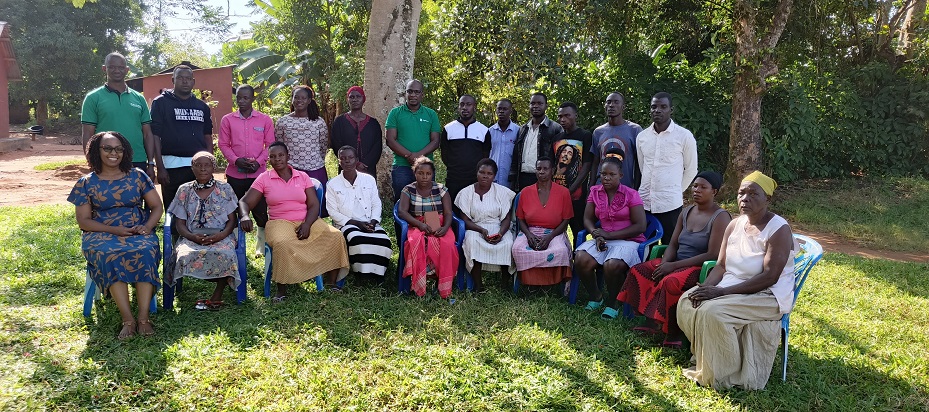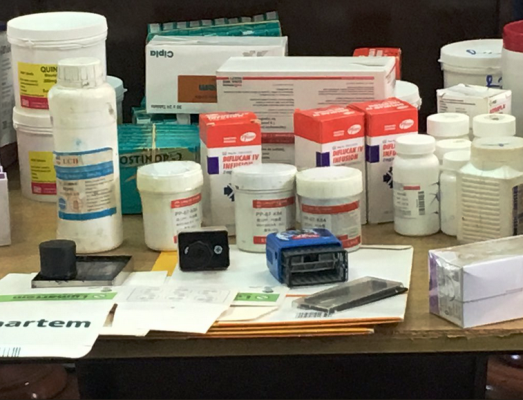Officials from ASARECA and M-Omulimisa in a group photo with farmers after sensitizing them on the benefits of agriculture insurance and use of technology to boost productivity
A team of researchers and technology experts are pushing for the adaption of agriculture insurance and use of weather prediction technologies to help mitigate effects of climate change that has crippled production among farmers in Uganda.
Championed by Association for Strengthening Agricultural Research in Eastern and Central Africa (ASARECA), a not-for-profit Inter-Governmental Organization created in 1994 and owned by the National Agricultural Research Institutes (NARIs) of 15 member States in Eastern and Central Africa (ECA), alongside M-Omulimisa, an innovative agri-tech company and Uganda Forum for Agricultural Advisory Services (UFAAS)), the team is traversing districts of Buikwe, Jinja, Bugiri and Mbale to sensitize farmers on the need to adopt agriculture insurance and new technologies to boost production.
Joshua Okonya, Programs Officer, Agriculture Technologies and Innovations at ASARECA, noted that the changing and unpredictable weather patterns have left farmers frustrated with limited knowledge on when to plant, calling for the need to promote proven climate-smart agricultural technologies to spur production.
“One of the newest technologies is agricultural insurance, weather index insurance. What is special about this insurance is that it guides the farmer on when to plant, when to harvest based on the amount of rainfall, it insures against two risks- drought or too much rainfall. Depending on the amount of rainfall that is received in a given area, we know how much water is needed for a crop to grow, so we are able to know that if the rain has been less by this amount, the yield will reduce by this percentage,” explained Okonya.
Abdul Ssentamu, a matooke, vegetable and Hass avocado farmer in Buikwe district, decried the harsh weather conditions characterized by prolonged dry spells yet the water sources are far from the gardens, prompting them to traditionally carry water in jerry cans to water gardens during the dry spell.
Sophia Nantaba, whose farm was chosen as a demonstration farm in Buikwe also decried the prolonged dry spells that are mitigated through irrigation, although this is also supplemented with collecting water in jerry cans.
“My challenges aren’t any different from my fellow farmers, especially the long dry spells. We have a tank that we use to collect water for irrigation, but when the tank dries up, we resort to buying water and it’s what we use for irrigation,” explained Nantaba.
According to Okonya, the agriculture insurance applies to farmers involved in commercial and monocrop farming that enables the use of GPS that can easily capture the garden and determine the insurance that’s due to the farmer in case of any compensation.
“So, the insurance is able to compensate the farmer for the percentage of the crop yield that has been lost. But if the yield is below 50%, the insurance compensates you 90%, like you would have received all the yield. This is a new product because now the climate has changed. We don’t know when the rain will begin, the seasons have changed, we can never rely on that,” he explained.
The M-Omulimisa App, has also leveraged on the use of digital platform to try to roll out the use of the digital platforms to the farmers, in order to bridge the need for extension workers within communities as the current ratios indicate that 1 extension worker is meant to serve 1,800 farmers.
This platform will provide farmers with knowledge on the market price, places to purchase quality seeds, crop diseases and treatment or prevention among others.

“We acknowledge that there are not enough extension workers to reach all the farmers. In Uganda, one extension worker is supposed to attend to like 1,800 farmers. They are not well-facilitated, so they are not able to reach many farmers. Even if they are present in a sub-county, a sub-country usually has one extension worker for crops. So, the use of the digital technologies enables the farmers or the village-based agents to access services by themselves, on their own, as long as they have either a smartphone to use the Android app, or to use the USSD codes. So, they are able to just dial a code and they receive market price information,” Okonya explained.
He added: “Often times, there is a problem of fake inputs, fake pesticides, fake seeds, nearly, everything is fake. But here, the people who sell their products on the platform have been verified to be genuine and there is traceability. In the case of any complaint, like low germination, we are able to trace who was the supplier. So, it’s not just somebody who colours the seed purple or green and packs them and sells them, the farmer plants and then gets 50% germination rate. They are also able to buy other things like solar products from the platform.”
During the interface with farmers, Nantaba also decried the low prices for agricultural produce especially poultry.
She explained: “In poultry farming, we have a challenge of the birds falling ill, but the biggest challenge is the low prices yet the animal feeds is expensive because there is little maize within communities yet it’s the main ingredient in animal feeds. The market prices for chicken is very low and when we sell the chicken, we aren’t able to recoup the money we invest in poultry. We are paid Shs9000 for a poultry bird raised for one month yet the least you could get in order to redeem the money invested is Shs10,000.”





